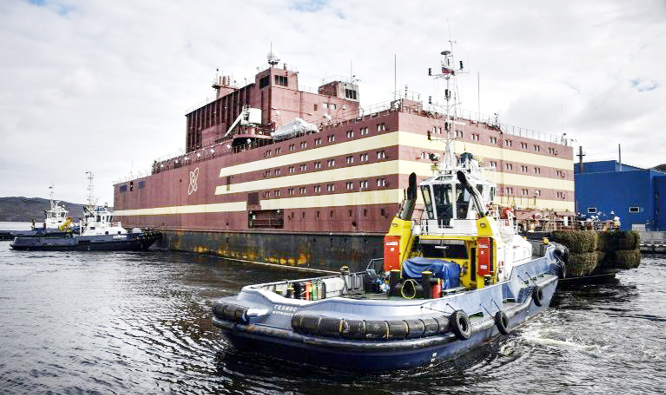
AFP, Moscow :
Russia will launch the world’s first floating nuclear reactor and send it on an epic journey across the Arctic on Friday, despite environmentalists warning of serious risks to the region.
Loaded with nuclear fuel, the Akademik Lomonosov will leave the Arctic port of Murmansk to begin its 5,000 kilometre (3,000-mile) voyage to northeastern Siberia.
Nuclear agency Rosatom says the reactor is a simpler alternative to building a conventional plant on ground that is frozen all year round, and it intends to sell such reactors abroad.
But environmental groups have long warned of the dangers of the project, dubbing it a potential “Chernobyl on ice” and a “nuclear Titanic.”
A deadly explosion this month at a military testing site in Russia’s far north, causing a radioactive surge, has prompted further concerns. The reactor’s trip is expected to last between four and six weeks, depending on the weather conditions and the amount of ice on the way. Work began on the 144-metre (472-foot) Akademik Lomonosov in Saint Petersburg in 2006.
When it arrives in Pevek, a town of 5,000 in the Siberian region of Chukotka, it will replace a local nuclear plant and a closed coal plant.
It is due to go into operation by the end of year, mainly serving the region’s oil platforms as Russia develops the exploitation of hydrocarbons in the Arctic.
Rashid Alimov, the head of the energy sector of Greenpeace Russia, said
environmental groups had been critical of the idea of a floating reactor
since the 1990s.
“Any nuclear power plant produces radioactive waste and can have an accident, but Akademik Lomonosov is additionally vulnerable to storms,” he told AFP.
The float is towed by other vessels, making a collision during a storm more likely, he said.
Because Rosatom plans to store spent fuel onboard, Alimov said “any accident involving this fuel might have a serious impact on the fragile environment of the Arctic.”
He added that there is “no infrastructure for a nuclear clean up” in the region.
Global warming and melting ice has made the Northeast Passage – which connects the Atlantic Ocean to the Pacific along Russia’s northern coast -more accessible.
When AFP visited the Akademik Lomonosov in May 2018, it was a shabby brown colour. It has since been repainted in the red, white and blue of the Russian flag.
The vessel weighs 21,000 tons and has two reactors with a capacity of 35 megawatts each, close to that of those used by nuclear icebreakers.
Russia will launch the world’s first floating nuclear reactor and send it on an epic journey across the Arctic on Friday, despite environmentalists warning of serious risks to the region.
Loaded with nuclear fuel, the Akademik Lomonosov will leave the Arctic port of Murmansk to begin its 5,000 kilometre (3,000-mile) voyage to northeastern Siberia.
Nuclear agency Rosatom says the reactor is a simpler alternative to building a conventional plant on ground that is frozen all year round, and it intends to sell such reactors abroad.
But environmental groups have long warned of the dangers of the project, dubbing it a potential “Chernobyl on ice” and a “nuclear Titanic.”
A deadly explosion this month at a military testing site in Russia’s far north, causing a radioactive surge, has prompted further concerns. The reactor’s trip is expected to last between four and six weeks, depending on the weather conditions and the amount of ice on the way. Work began on the 144-metre (472-foot) Akademik Lomonosov in Saint Petersburg in 2006.
When it arrives in Pevek, a town of 5,000 in the Siberian region of Chukotka, it will replace a local nuclear plant and a closed coal plant.
It is due to go into operation by the end of year, mainly serving the region’s oil platforms as Russia develops the exploitation of hydrocarbons in the Arctic.
Rashid Alimov, the head of the energy sector of Greenpeace Russia, said
environmental groups had been critical of the idea of a floating reactor
since the 1990s.
“Any nuclear power plant produces radioactive waste and can have an accident, but Akademik Lomonosov is additionally vulnerable to storms,” he told AFP.
The float is towed by other vessels, making a collision during a storm more likely, he said.
Because Rosatom plans to store spent fuel onboard, Alimov said “any accident involving this fuel might have a serious impact on the fragile environment of the Arctic.”
He added that there is “no infrastructure for a nuclear clean up” in the region.
Global warming and melting ice has made the Northeast Passage – which connects the Atlantic Ocean to the Pacific along Russia’s northern coast -more accessible.
When AFP visited the Akademik Lomonosov in May 2018, it was a shabby brown colour. It has since been repainted in the red, white and blue of the Russian flag.
The vessel weighs 21,000 tons and has two reactors with a capacity of 35 megawatts each, close to that of those used by nuclear icebreakers.

